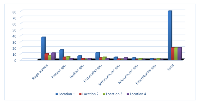Public Health Consequences of Pathogenic Bacterial Contamination of Ready to Eat Food/ Snacks from Some Selected Retail Outlets on Campus of Rivers State University, Port Harcourt, Nigeria
Keywords:
Public Health, Food Poisoning, Food Safety, Health Education, Health Risk Assessment, Ready to eat Food/Snacks, Campus, HACCPAbstract
Campus lifestyle is seemingly always characterized with doing things at ease without stress thus; consumption of ready to eat food is a common life style among students on campus with much interest on convenience rather than its safety and quality. Food borne illness is a major challenge to the health of the public; it has significantly contributed to the cost of health related outcome globally.
Annually, millions of illnesses across the world could literally be attributed to the consumption of contaminated foods. Ingestion of contaminated ready to eat foods has been documented to serve as a strong vehicle for transmission of numerous pathogens and food borne outbreak. An observational descriptive study was explored to evaluate the safety standard and bacteriological quality of two
common ready to eat foods (meat pie and moi-moi) from four different selected retail snacks outlets on campus. This will further help to ascertain their public health implication among the unsuspected public. Samples were collected from the four selected retail points, examined using conventional microbiological methods for the isolation and identifications of the implicated pathogens. Graphpad
calculator was used to analyse data for mean, standard deviation and one way ANOVA at 0.05 were also explored respectively. Seven bacteria isolates were identified from the ready to eat snacks. The result of the isolation based on frequency and prevalence rate revealed that Staphylococcus aureuswas the highest and most predominant amongst the isolated organisms 65 (46.4%); followed by
Proteus spp. 27 (19.3%), then Escherichia spp. 21 (15%) whereas, Enterobacter spp. 4 (2.9%) had the least respectively. Based on the location sampled, Location 1 had the highest prevalence rate (57.1%) while others had same rates (14.3%). ANOVA showed no indication of statistical significance difference (p>0.05) between the four different locations.. However, the application of hazard analysis critical control point at all stages of food preparation and handling will be helpful,as a good pathway towards enhancing food safety in our campuses and communities at large
Downloads
References
Adams MR and Moss MO (2000). Food Microbiology. Royal Society of the Chemistry, Cambridge, UK.. 479.
Adesiyun, A. A., L. A. Webb, and H. T. Romain. (1998). Prevalence and characteristics of Staphylococcus aureus strains isolated from bulk and composite milk and cattle handlers. J. Food Prot. 61:629.
Agbodaze, D., P.N. Nmai, F. Robertson, D. Yeboah-Manu, K. Owusu-Darko and K. Addo (2005). Microbiological quality of khebab consumed in the accra metropolis. Ghana. Med. J., 39: 46-49.
American Public Health Association "A. P. H. A."(1998). Standard Methods for the Examination of Dairy Products. 15th ed., Washington, DC.
Barro, N., Bello, A. R., Itsiembou, Y., Savadogo, A., and Ouattara, C. A. T. (2007). Street Vended Foods Improvement: Contamination mechanisms and application of food safety objective strategy: Critical review, 6:01-10.
Borch, E. & Arinder, P. (2002). Bacteriological safety issues in red meat & ready to eat meat products, as well as control measures. Meat Sc., 62: 381-390.
Buttiaux, R., and Mossel, D. A. A., (2005). The significance of Various organisms of Faecal origin in foods and drinking water. Journal of Applied Bacteriology. 24. 353-364.
Chakravarty, I. and C. Canet (1996). Street foods in Calcutta. FNA/ANA 17/18, 1996, FAO, Rome, Italy, pp: 30-37.
ftp://ftp.fao.org/docrep/fao/W3699T/W3699t04.pdf.
Ghosh, M., S. Wahi, M. Kumar and A. Ganguli (2007). Prevalence of enterotoxigenic Staphylococcus aureusand Shigella spp. in some raw street vended Indian foods. Int. J. Environ. Health Res., 17: 151-156
Chomvarin C, Chantarasuk Y, Srigulbutr S, Chareonsudjai S and Chaicumpar K. (2006). Enteropathogenic bacteria and enterotoxin-producing Staphylococcus aureus isolated from ready-to-eat foods in Khon Kaen Thailand. Southeast Asian Journal of Tropical Medicine and Public Health. 37(5): 983-90.
Cheesebrough, M. (2000). District laboratory practice in tropical countries part 2. Cambridge University press pp 76- 100.Eley, A. R. (1996). Microbial Food Poisoning. 2nd ed., Chapman & Hall, London, UK.
Food and Agriculture organization of the United Nations FAO (1991): Manuals of food quality control 4 microbiological analysis D 1 -D37.
Frazier, W.C., and Westthroff, W. C.,(2006). Food Microbiology 3rd edition, M c Graw Hill publishing company limited NewYorkpp 163-165.
Ghosh, N., Anuradha, T. N., and Vandana, Q. A. (2007). Food safety in urban food catering Service - Experiences in the Food and nutrition security Community.
Graffham A, Zulu R and Chibanda D (2005). Improving the safety of street vended foods in Southern Africa. Final Report, CPHP project R8272, 2005
Hatakka, M. (1998). Microbiological quality of hot meals served by airlines .J. of Food Protection. 61(8):1052-1056.
Ike, C. C., Emeka-Ike, P. C., Nwokorie, C. C, Anochie, C. C. (2015). Microbiological quality evaluation of locally prepared snacks sold in Aba
metropolis, Abia state, Nigeria. International Journal of Scientific Engineering and Applied Science (IJSEAS). 1(7). 2395-3470. 46-59.
www.ijseas.com
Jay, J. M., (2002) Modern food Microbiology Coliform Bacteria as indicators of food sanitary quality S.K. Jam for C B S Publishers Pp. 410-417.
Jay, M.J., (2005). Modern Food Microbiology 4th edth. Chapman and hill New York. Pp. 187.Muinde, O.K. and E. Kuria (2005). Hygienic and sanitary practices of vendors of street foods in Nairobi, Kenya. Afr. J. Food Agric. Nutr. Dev. 5: 1-15.
World Health Organization (WHO) (2001). Background paper: Developing a food safety strategy. WHO Strategic Planning Meeting. Geneva.
World Health Organization - WHO (2003). Module a decentralization policies and practices: Case study Ghana. Participants Manual, Geneva.http://info.worldbank.org/etools/docs/library/205756/sloga/docs/sloga/MODA-EN-CaseStudyGhana.pdf.
World Health Organization (2007). World Health Statistics, Geneva. WHO 2007.Nielsen AC.2006. Ready to eat meals: Global highlights. A global consumer survey report. Safety Practice among Food Vendors in Ilorin. J. Med. 5:120 – 124.
Pyley, J., (2000). The impact of fast foods on U.K nutrition l6:Pp. 1-10.Ray, B. (1996). Fundamental Food Microbiology. CRC Press, Inc., Tokyo, New York.
Roberts, D. and Greenwood, M., (2003). Practical food microbiology Blackwell publishing ltd, oxford U.k.
Robinson, R.K. (1990). Dairy Microbiology. 2nd ed., Chapman & Hall, London, New York.
Schiller L.R., Scum J.H., Feidmam M. and Brandt L.J (2010). Gastro intestinal and liver Disease 9th edition Philadelphia Pa: chapter 15

Downloads
Published
Issue
Section
License

This work is licensed under a Creative Commons Attribution-NonCommercial-ShareAlike 4.0 International License.







